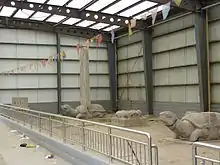Xiao Xiu
Xiao Xiu (Chinese: 蕭秀; pinyin: Xiāo xiù), styled Prince Anchengkang (Chinese: 安成康王; pinyin: Ancheng Kang Wang, also translated as Prince Kang of Ancheng) (475–518),[1] was a younger half-brother of Emperor Wu, the first emperor of China's Liang Dynasty (who had the personal name of Xiao Yan). According to the Liang Shu, he was the 7th son of the Xiao Yan's father Xiao Shunzhi.[1]

Xiao Xiu is said to have been a disciple of the Buddhist monk Daodu (道度, 462–527).[1]
Xiao Xiu's Mausoleum

Xiao Xiu is better remembered not for what he did while alive, but for his tomb, whose assortment of animal sculptures is the most complete set of such statuary surviving from that period.[2][3]
Xiao Xiu's tomb is located in the Ganjia Lane (Chinese: 甘家巷; pinyin: Gānjiā xiàng) neighborhood in today's Qixia District north-east of Nanjing (32°08′38″N 118°55′02″E). It is thought that the sculptural ensemble of the tomb included a pair of winged lion-like animals (bixie), four steles supported by stone tortoises, and a pair of fluted columns.[4] Visited and photographed by Victor Segalen in 1917, the ensemble of the Tomb of Xiao Xiu (with his name better known under its French transcription, Siao Sieou)[5] soon became well known to Europe's and the world's students of ancient Chinese sculpture. Presently, the site is on the grounds of Gan Jia Xiang Elementary School.[3]
Notes
| Wikimedia Commons has media related to Tomb of Xiao Xiu. |
- Benn, James A. (2007), Burning for the Buddha: self-immolation in Chinese Buddhism, Issue 19 of Studies in East Asian Buddhism, University of Hawaii Press, pp. 3, 243, 261, ISBN 0-8248-2992-1
- Angela Falco Howard, Li Song, Wu Hung, Yang Hong, «Chinese Sculpture». Yale University Press and Foreign Languages Press, 2006. ISBN 0-300-10065-5. Pp. 163–165; photo in Fig. 2.63
- Mausoleum Stone Carvings of Southern Dynasties in Nanjing Archived July 25, 2011, at the Wayback Machine
- Albert E. Dien, «Six Dynasties Civilization». Yale University Press, 2007 ISBN 0-300-07404-2. Partial text on Google Books. P. 190. A reconstruction of the original form of the ensemble is shown in Fig. 5.19.
- Victor Segalen, Chine. La grande statuaire, and Les origines de la statuaire en Chine (in French)
External links
- 梁安成康王萧秀墓石刻 (Sculptures at the Tomb of Xiao Xiu) (in Chinese) (Xiao Xiu's brief biography; description and modern photos of his tomb statuary ensemble)
